VDO Dayton 4W315C User Manual
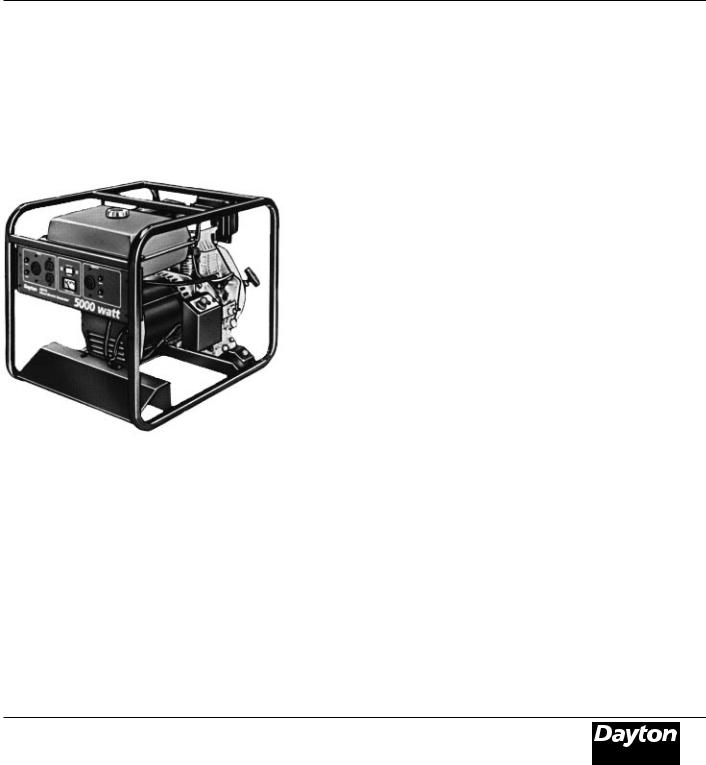
Operating Instructions & Parts Manual |
4W315C |
|
|
Please read and save these instructions. Read carefully before attempting to assemble, install, operate or maintain the product described. Protect yourself and others by observing all safety information. Failure to comply with instructions could result in personal injury and/or property damage! Retain instructions for future reference.
Dayton® Diesel Electric
Generator
Description
Dayton professional-duty generators are rugged and compact. These models provide dependable, trouble-free service. The alternators are brushless with revolving fields. Yanmar diesel engines provide long life under heavy use. These engines are governed to maintain engine speed of 3600 RPM under load. 3600 RPM engine speed provides 120/ 240V, 60 Hz power. Additional features include circuit breaker protection, spark-arresting muffler, large fuel tank, oil alert system, electric starter, and a pressurized lubrication system.
Unpacking
1.Remove generator from carton.
2.Remove any protective packaging applied to generator for shipment.
3.Check for loose or missing parts. Check for shipping damage. If any parts are missing or damaged, promptly inform dealer where you bought generator.
4.Battery cables are supplied. These cables are in a separate bag inside generator carton. You must install these cables to engine. See “Battery,” page 7 for installation instructions.
Figure 1 – Model 4W315C
Form 5S3125
®
Printed in U.S.A. |
|
|
03430 |
|
|
0703/215/VCPVP |
Version B - For Reduction |
G016.J |

Dayton Operating Instructions and Parts Manual |
4W315C |
Dayton® Diesel Electric Generator
Specifications
ELECTRICAL SPECIFICATIONS
Rated |
Maximum |
Rated Amperage |
Rated Amperage |
Wattage* |
VA |
120V |
240V |
5000 |
6500 |
41.7 |
20.8 |
* Single-phase, 1.0 power factor
NOTE: Ratings apply to SAE standard conditions. Reduce ratings 3 1/2% for each 1000 feet above sea level and 1% for each 10° Fahrenheit rise above 60°F.
GENERAL SPECIFICATIONS
Yanmar |
Yanmar |
Fuel |
Fuel Tank |
Oil Alert |
Electric |
Weight |
Engine H.P. |
Model |
Type |
Capacity |
System |
Start |
(pounds) |
10 |
L100 |
Diesel |
4.2 gal. |
Yes |
Yes |
241 |
RECEPTACLE SPECIFICATIONS
120V |
120V, 30-Amp |
120/240V, 20-Amp |
120V Full |
Duplex |
Twist-Lock |
Twist-Lock |
Power Switch |
Yes |
Yes |
Yes |
Yes |
ELECTRICAL COMPONENT SPECIFICATIONS
|
Resistance in Ohms |
|
|
|
||
Stator |
Stator |
|
Rotor |
Rotor |
Capacitor, |
|
Main |
Auxiliary |
∆ |
Primary |
Secondary |
MFD |
Diodes (2) |
Winding * |
Winding |
Winding † |
Winding † |
450 Volt |
800 Volt |
|
0.54 |
1.38 |
|
0.61 |
2.29 |
50 |
70 Amp |
(*) Connect T2 (green) and T3 (black). Measure resistance between T1 (red) and T4 (yellow). (∆) Resistance between brown and white leads.
(†) Remove diodes to check resistance.
107358
2
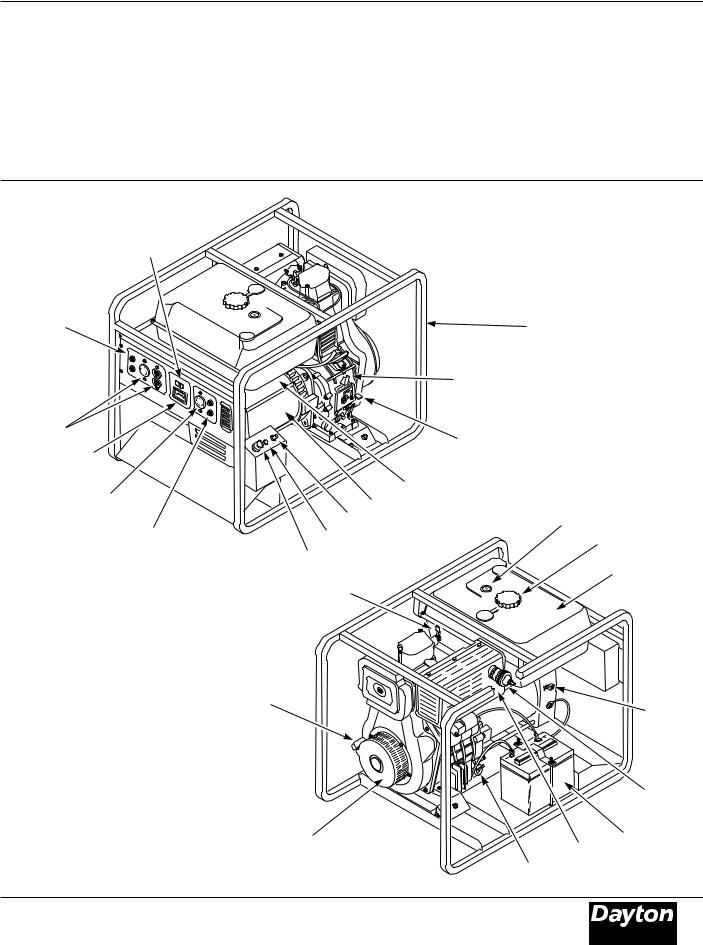
Dayton Operating Instructions and Parts Manual
Model 4W315C
Product Identification
Full Power
Selector Switch
Control Panel
120V OLTS
120
|
SELECTOR |
120/240V |
|
|
|
|
|
0 |
100 |
|
|
|
|
200 |
|
|
AC |
VOLTS |
30 |
|
|
|
|
|
UT V |
|
|
120 Volt
Receptacles
Hour Meter
120/240 Volt
Receptacle
Circuit
Breaker
Figure 2 – Portable Generator
E |
F |
|
|
|
|
|
|
|
|
|
Roll Cage |
|
|
Engine Run Lever |
|
120/240V |
|
|
|
OLTS |
|
|
|
|
|
Engine Stop Lever |
|
|
Fuel Valve (under fuel tank) |
||
|
Alternator |
|
|
|
Oil Alert Lamp |
|
Fuel Gage |
|
Battery Discharge Lamp |
|
Fuel Cap |
|
|
|
|
|
Electric Start Switch |
|
|
|
|
|
Fuel Tank |
|
Decompression |
F |
E |
|
|
|
|
|
Lever |
|
|
Starter Grip
Ground
Lug
|
Spark |
|
|
Arrester |
|
Engine |
Battery (Not |
|
included, must |
||
Muffler |
||
be purchased |
||
|
||
Oil Dipstick |
separately) |
®
107358
3
Version B - For Reduction |
G016.J |

Dayton Operating Instructions and Parts Manual |
4W315C |
Dayton® Diesel Electric Generator
General Safety Information
IMPORTANT: Read these instructions and engine owner’s manual carefully. Become familiar with generator before trying to operate or service it. Know its uses, limitations, and any hazards involved. Improper use of generator can cause severe injury or death from explosion, fire, burns, electrical shock, or carbon monoxide poisoning.
Make certain you read and understand all warnings. Keep these instructions for reference. They are your guide to safe and proper operation of this generator.
Safety information appears throughout these instructions. Pay close attention to them. Below are definitions for the safety information listed throughout this manual.
Under this heading, installation, operat-
ing, and maintenance procedures or practices will be found that, if not carefully followed, WILL result in IMMEDIATE serious personal injury or death.
Under this heading, installation, operat-
ing, and maintenance procedures or practices will be found that, if not carefully followed, COULD result in severe personal injury or death.
Under this heading, installation, operat-
ing, and maintenance procedures or practices will be found that, if not carefully followed, MAY result in minor personal injury, product or property damage.
Engine exhaust contains poisonous
carbon monoxide gas. Overexposure will cause loss of consciousness and will lead to death. Use only in wellvented areas. Make sure area has plenty of free-moving, fresh, outside air. Never run generator in an enclosed or confined area. Never run generator inside occupied building.
Early signs of carbon monoxide poisoning resemble the flu, with headaches, dizziness, or nausea. If you have these signs, get fresh air at once! Some people are more affected by carbon monoxide than others. These include pregnant women, persons with heart or lung disease or anemia, those under the influence of alcohol, and those at high altitudes.
Diesel fuel presents a hazard of
fire. Diesel fuel is flammable.
•Keep fuel out of children’s reach.
•Refuel generator in a well-vented area. Do not fill fuel tank in the dark. Do not refuel while engine is running. Unhook all electrical loads and shut off engine before refueling.
•Do not overfill fuel tank. Always allow room for fuel to expand. If you overfill tank, fuel can overflow onto hot generator. This can cause fire. After refueling, tightly close fuel tank cap.
•Do not spill fuel. If fuel spills, make sure area is dry before starting engine.
•Never smoke in refueling area. Never allow open flames or sparks in area.
•Store fuel in approved container. Store fuel in a well-vented area free of open flames or sparks.
Guard against fire hazard. Keep
operation area well-vented. Keep generator at least three feet away from any object. Do not place flammable objects near generator.
•Do not use generator where flammable vapors are present. Some vapors are heavier than air. These vapors settle in low-lying places.
•Do not use generator in enclosed spaces. This includes motor home or RV generator compartments.
Guard against electric shock.
Generator produces high voltage. This high voltage can cause severe electric shock. Only responsible adults should use the generator.
•Properly ground generator before starting.
•Never let anyone operate or service generator without proper instructions.
•Avoid contact with live terminals or bare wires.
•Do not use generator outdoors in rain or snow.
•Do not use generator near standing water or snow.
•Do not use if generator is wet or damp.
•Do not use generator in highly conductive areas. These areas include metal decking and steelwork.
•Only use grounded extension cords.
•Do not use any worn or damaged electric cords. Electric shock or damage to generator may result.
•On construction sites, you must use a Ground Fault Circuit Interrupter (GFCI). This helps guard against electric shock. OSHA and the National Electrical Code requires this.
•Do not wear damp clothing or wet shoes when using generator.
107358
4
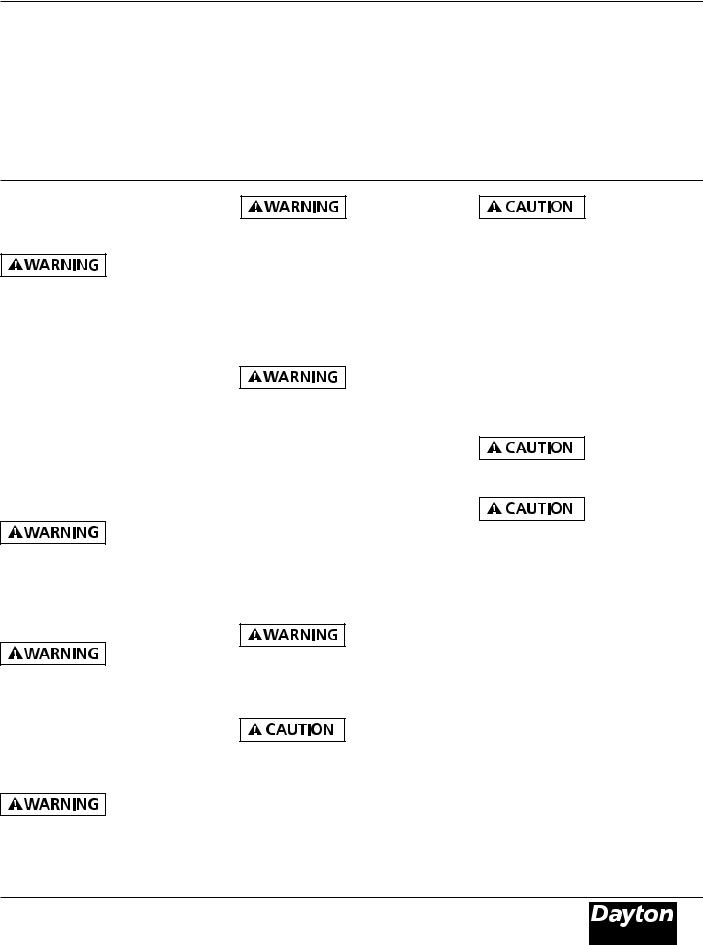
Dayton Operating Instructions and Parts Manual
Model 4W315C
General Safety Information (Continued)
Guard against burns. Hot engine
parts can cause severe injury. Use caution and remain alert when using generator.
•Keep children and animals away from generator while it is running or hot.
•Keep all covers and shields in place. Keep them tightly secured.
•The muffler becomes very hot during operation. The muffler remains hot for a while after shutdown. Do not touch muffler while it is hot. Do not let muffler touch anything flammable. Let engine cool before transporting or storing.
Have standby installation to
home or building performed by a licensed electrician. Do not let anyone else wire into a utility circuit. Personal injury, equipment damage, or damage to home could occur.
Never connect generator to any
existing electrical circuits. The generator output will back-feed into the utility power line. This may electrocute a power company line repair person. Also, if generator is powering electrical circuits, the chance of an electrical fire exists.
Battery gives off explosive gases.
Keep sparks, flames, and cigarettes away. Do not remove or install battery cables when engine is cranking or running. Only service or use battery in a well-vented area.
Battery contains sulfuric acid.
Battery acid is poisonous if swallowed. Contact with skin or eyes may cause severe burns. Do not tilt generator with battery installed. Tilting could cause battery acid to spill. Wear protective clothing and face shield when servicing. Keep out of children’s reach.
Only a qualified electrical service
person should service and repair generator.
•Generator produces high voltage. Use extreme caution when working on electrical parts.
•When working on generator, avoid hot muffler, exhaust manifold, and engine parts. Severe burns may occur.
•Do not work on generator when tired.
•Use only factory approved replacement parts.
Store generator in a well-vented area.
Make sure fuel tank is empty. Never store with fuel in tank.
Never operate generator
•if engine speed changes greatly
•if engine misfires often
•if powered items overheat
•if electrical output drops
•if it is sparking
•if it produces smoke or flames
•if it vibrates at high levels
•if it has a damaged receptacle
Keep generator and nearby areas
clean.
•Keep generator free of oil, mud, and other foreign matter.
•Remove anything that creates slippery areas around generator.
•Remove oily rags and other items that create fire hazards.
•Keep a fire extinguisher nearby. Make sure it is rated ABC by the NFPA. They are good for all uses.
Consult your local fire department.
•Keep fire extinguisher well maintained. Be familiar with its use.
Know how to stop engine quickly.
Know how to use all controls.
Prolonged exposure to loud noise
can cause hearing loss.
•When working around generator, wear approved hearing protection.
•Remember neighbors when using generator.
Generator Features
OIL ALERT SYSTEM
The oil alert system protects the engine from low oil damage. This system automatically shuts down the engine and prevents engine restarting if the oil pressure falls too low.
If this system shuts down the engine, the engine will not start until you add oil. The oil alert lamp is near engine starter switch (See Figure 3, page 6). Add oil to engine (See “Engine Oil,” page 8).
See engine owner’s manual for more information.
®
107358
5
Version B - For Reduction |
G016.J |
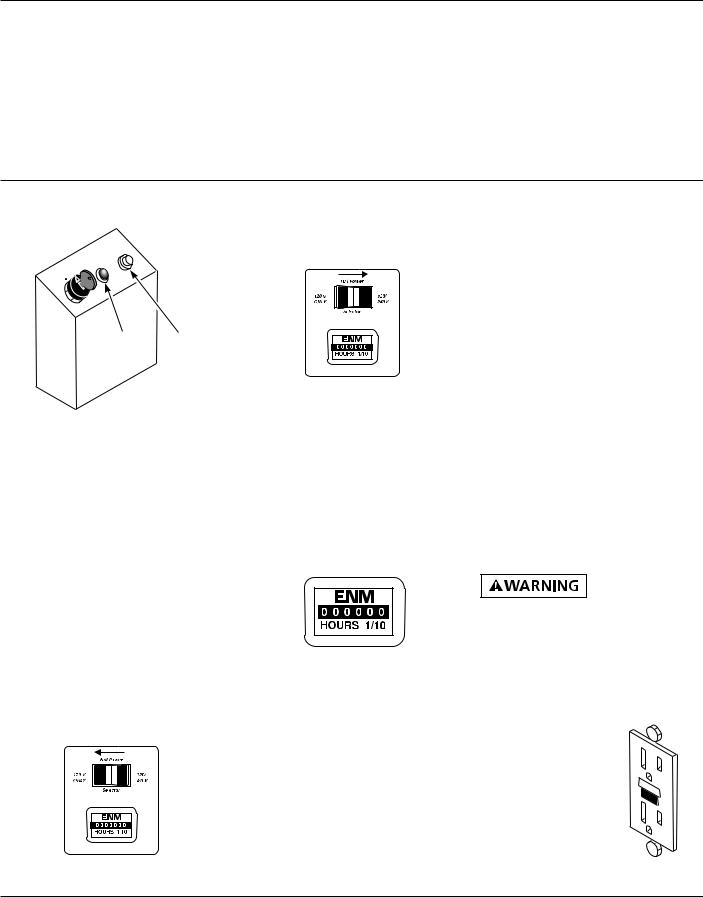
Dayton Operating Instructions and Parts Manual |
4W315C |
Dayton® Diesel Electric Generator
Generator Features (Continued)
OIL
CHARGE
OFF
Battery |
Oil Alert |
Discharge |
Lamp |
Lamp |
|
120/240 VOLT: This position sends full power to the 120/240V receptacle. It also powers the 120V receptacles at reduced wattage capacity.
Figure 3 - Battery Discharge Lamp and Oil
Alert Lamp Location
BATTERY DISCHARGE LAMP
The battery discharge lamp (See Figure 3, above) will light if battery charger is not operating while engine is running. If this happens, the battery will not charge and will eventually run down. Have battery charging circuit repaired by authorized service person.
FULL POWER SELECTOR SWITCH
The full power selector switch is on the control panel. The switch has two positions: 120 VOLT ONLY, and 120/240 VOLT.
120 VOLT ONLY: This position sends full power to the 120V receptacles only. 240V power is not available. Use this position when powering 120V items only.
Figure 4 – Full Power Selector Switch in 120 Volt Only Position
Figure 5 – Full Power Selector Switch in 120/240 Volt Position
IMPORTANT: Do not move the full power selector switch while powering electrical items. Unplug all items before moving switch. Failure to do so can damage switch.
HOUR METER
The hour meter will measure the total run time of the generator, including all idle time. Hour meter is accurate up to 1/10 of an hour.
Figure 6 – Hour Meter
ELECTRIC START
A battery is not supplied with generator. You must provide a 12-volt, 45-amp-hour battery. For more battery information, see “Battery,” page 7.
GROUND FAULT CIRCUIT INTERRUPTER RECEPTACLE
This generator has a 120-volt ground fault circuit interrupter (GFCI) receptacle. The GFCI receptacle is on the control panel. The GFCI protects you against hazardous
electrical shock caused when your body becomes a path through which electricity travels to reach ground. This could happen when you touch an appliance or cord that is ‘live’ through faulty mechanism, damp or worn insulation, etc.
When protected by the GFCI, you may still feel a shock, but the GFCI should cut it off quickly. A person in normal health should not receive serious injury.
NOTE: Infants and very small children may still be affected.
TEST PROCEDURE
Check the GFCI receptacle every month. This insures it is working right.
1.Push black TEST button. Red RESET button should pop out. This should trip GFCI, resulting in no electrical power at receptacle. Verify this by plugging test lamp with good bulb into receptacle. If lamp does not work, GFCI receptacle is good.
If RESET button does not pop out,
do not use the GFCI receptacle. Contact a qualified electrician for repairs.
2.If the GFCI receptacle tests okay, restore power by pushing the RESET button back in. The test lamp should work at this time.
IMPORTANT: You |
|
must press the RESET |
|
button firmly and fully. |
|
It should lock into |
|
place. If the GFCI does |
RESET |
not lock into place, do |
TEST |
|
not use receptacle. Contact a qualified electrician for repairs.
Figure 7 – GFCI Receptacle
107358
6
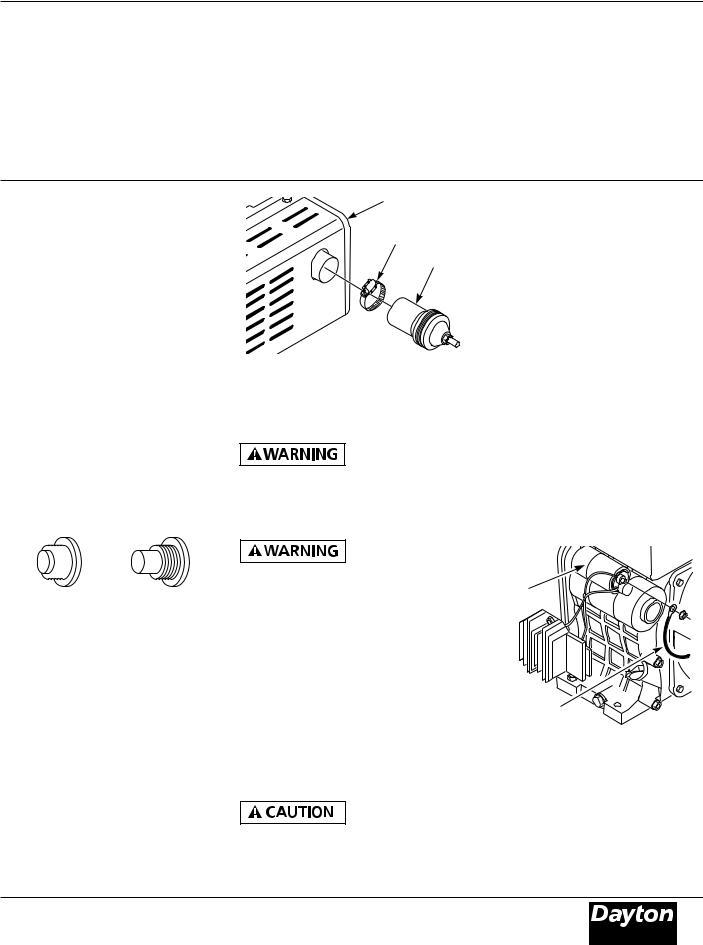
Dayton Operating Instructions and Parts Manual
Model 4W315C
Generator Features (Continued)
RECEPTACLE CIRCUIT BREAKER
The circuit breakers protect the receptacles and alternator. Overloading generator will trip circuit breaker. A short circuit in item being powered will also trip breaker. If this occurs, unplug electrical load from receptacle. Let circuit breaker cool down. Push circuit breaker button to reset.
Electric motors need higher starting current. They require up to 3-times their rated wattage to start. The starting current needed may be too high. This can cause nuisance circuit breaker tripping. To help prevent this, start electric motors first. Connect additional items to generator after starting motors. If this continues to happen, reduce the total generator load.
20 20
20
Normal |
Tripped |
Figure 8 – Receptacle Circuit Breaker Button
SPARK ARRESTER
We ship a spark arrester with this generator. You must install spark arrester to muffler (See Figure 9).
A spark arrester is required if using generator in a national forest and other designated state and local areas. Check local codes.
The spark arrester needs periodic cleaning. A dirty spark arrester reduces engine output and increases fuel consumption. It also makes starting difficult. See engine owner’s manual for cleaning instructions.
Muffler
Clamp
Spark
Arrester
Figure 9 - Installing Spark Arrester
Assembly
BATTERY
Battery gives off explosive gases.
Keep sparks, flames, and cigarettes away. Do not remove or install battery cables when engine is cranking or running. Only service or use battery in a well-vented area.
Battery contains sulfuric acid.
Contact with skin or eyes may cause severe burns. Do not tilt generator with battery installed. Tilting could cause battery acid to spill. Wear protective clothing and face shield when servicing. Keep out of children’s reach.
•If battery acid gets on your skin, wash with water.
•If battery acid gets in your eyes, flush with water at least 15 minutes. Call a doctor at once.
Battery acid is poisonous.
•If swallowed, drink large amounts of water or milk. Follow with milk
of magnesia or vegetable oil. Call a doctor at once.
If you remove battery, insulate
the red, positive (+) battery cable terminal. Insulate with electrical tape. Exposed terminal may spark when generator runs.
IMPORTANT: Make sure battery connections are the correct polarity. Electric start generators use negative ground, 12-volt DC starting system.
A battery is not supplied with generator. You must provide a 12-volt, 45-amp-hour battery. The positive and negative battery cables are supplied with generator. You must install these cables before mounting battery.
Always wear safety glasses when working with battery. Make sure battery terminals are clean. Make sure cable connections are tight.
Always shut down engine before removing or attaching battery cables. Always remove the negative (–) cable first. Always attach negative (–) cable last.
INSTALLING BATTERY CABLES TO ENGINE
1.Attach the red, positive (+) battery cable to the starter solenoid on engine (See
Figure 10).
Starter
Solenoid
Red, Positive (+)
Battery Cable
Figure 10 – Connecting Red, Positive (+) Battery Cable to Starter Solenoid on Engine
2.Attach the black, negative (–) battery cable to the engine block. Use the bolt, nut, and two washers provided with the battery cables. Attach cable as shown in Figure 11, page 8.
®
107358
7
Version B - For Reduction |
G016.J |
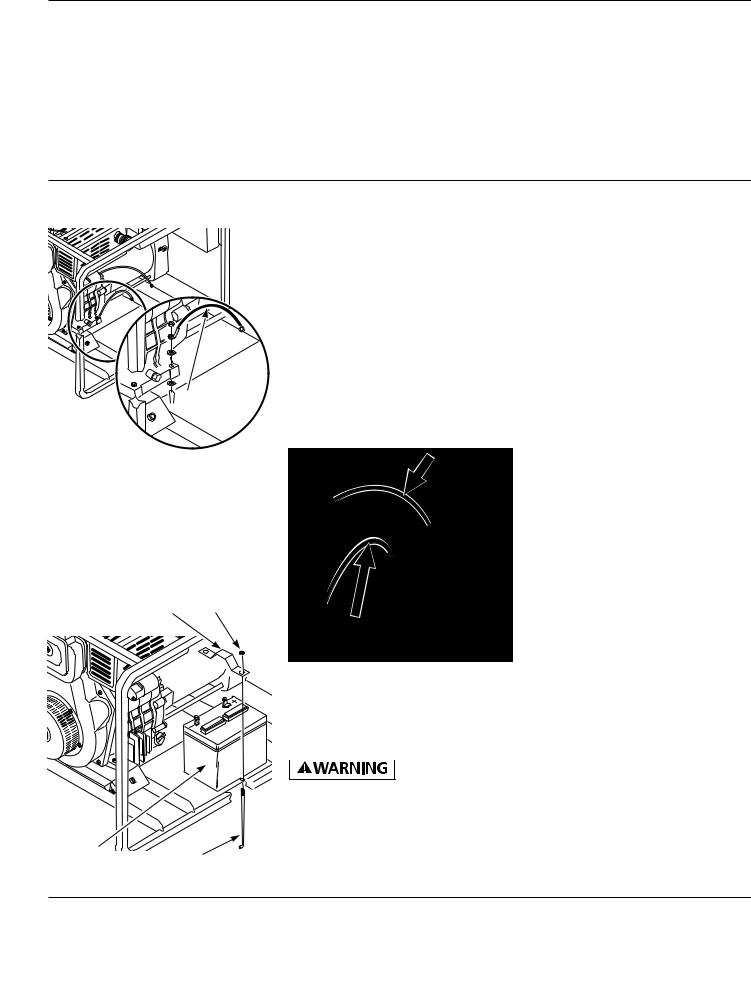
Dayton Operating Instructions and Parts Manual |
4W315C |
Dayton® Diesel Electric Generator
Assembly (Continued)
 Black, Negative (–)
Black, Negative (–)
 Battery Cable
Battery Cable
Figure 11 – Connecting Black, Negative (–) Battery Cable to Engine Block
MOUNTING BATTERY TO GENERATOR
1.Secure battery to generator by battery hold-down system. This system consists of the battery mounting bracket, hook bolt, and nut (See Figure 12).
Battery Mounting |
Nut |
Bracket |
|
Battery
Hook Bolt
Figure 12 – Battery Hold-Down System
2.Locate the red, positive (+) battery cable from starter solenoid. Connect it to the positive (+) battery terminal (See Figure 13).
3.Locate the black, negative (–) battery cable attached to engine block. Connect it to the negative (–) battery terminal (See Figure 13).
•Do not overfill fuel tank. Always allow room for fuel to expand. If you overfill tank, fuel can overflow onto hot engine. This can cause fire. After refueling, tightly close fuel tank cap.
•Do not spill fuel. If fuel spills, make sure area is dry before starting engine.
•Never smoke in refueling area. Never allow open flames or sparks in area.
4.Check battery before starting engine. Make sure fluid levels are full. Make sure battery is charged.
See engine owner’s manual for more information.
Red, Positive Cable
From Starter Solenoid
•Store fuel in approved container. Store fuel in a well-vented area free of open flames or sparks.
Use clean, fresh, diesel fuel. Use diesel fuel with cetane rating of 45 or higher. Avoid getting dirt, dust, or water in fuel tank. See engine owner’s manual for more information.
|
ENGINE OIL |
|
|
We ship the generator without oil in the |
|
|
engine crankcase. You must add oil before |
|
|
starting engine. See “Engine Lube Oil,” |
|
|
page 9 for specific oil type. |
|
|
CHECKING OIL LEVEL AND ADDING OIL |
|
|
Follow steps below to check oil level. |
|
|
Make sure engine is level and stopped. |
|
Black, Negative |
1. Remove dipstick (See Figure 14). Wipe |
|
dipstick clean. |
||
Cable From |
||
Engine Block |
2. Insert dipstick into oil filler neck. Do not |
|
|
||
|
screw it in. Oil level should be at top of |
|
Figure 13 – Connecting Positive and |
filler neck. Oil should cover most of |
|
Negative Cables to Battery |
dipstick. |
|
|
||
Installation |
3. If level is low, fill to top of oil filler neck |
|
(See Figure 14). Use proper lube oil to |
||
FUEL |
||
preserve your engine. |
||
Diesel fuel pre- |
||
NOTE: If oil level is too low, oil alert |
||
sents a hazard of |
||
fire. Diesel fuel is flammable. |
system will shutdown engine and prevent |
|
• Keep fuel out of children’s reach. |
engine from restarting. |
•Refuel generator in a well-vented area. Do not fill fuel tank in the dark. Do not refuel while engine is running. Unhook all electrical loads and shut off engine before refueling.
107358
8

Dayton Operating Instructions and Parts Manual
Model 4W315C
Installation (Continued)
Oil Level
At Top Of
Filler Neck
Dipstick
Oil
Figure 14 – Checking Oil Level
ENGINE LUBE OIL
Nothing affects the performance and durability of your engine more than the lube oil you use. Using inferior oil or not changing oil regularly increases the risk of piston seizure, piston ring sticking, and accelerated wear of cylinder liner, bearing and other moving parts. Your engine life may be seriously shortened. Yanmar recommends CC/CD oil of API engine service classification, stock number 4ZF20.
Always use oil with the right viscosity for the ambient temperature in which you are using the engine. Use the chart below when choosing your engine oil.
Lube Oil Capacity:
4W315C 1.74 qt.
20W 40
10W 30
Locate ground lug on end of generator housing (See Figure 15). Attach a #10 stranded-copper ground wire to ground lug. Drive grounding point into ground. Grounding point can be a stake, grounding rod, or pipe. Grounding point should be copper or brass. Attach ground wire to grounding point. You must supply the ground wire and grounding point. They do not come with generator. Follow the National Electrical Code and all state and local codes. Consult your power company or a licensed electrician.
VENTILATION
Use only in wellvented areas. Make
sure area has plenty of free-moving, fresh, outside air. Never run generator in an enclosed or confined area. Never run generator inside occupied building. Engine exhaust contains poisonous carbon monoxide gas. Overexposure will cause loss of consciousness and will lead to death.
This generator needs cooling air to run properly. Never block free-flowing, cooling air to generator. Overheating will occur without cooling air. This will damage the generator. Keep generator at least three feet away from any object.
GENERATOR GROUNDING
You must properly earth-ground
generator before starting. This will help guard against deadly electric shock. Only use grounded plugs with generator. Only use grounded extension cords. Only use three-wire or double-insulated power tools.
Grounding generator helps prevent electric shock from a ground fault condition.
Ground Lug
Copper or
Brass
Grounding
Point
Alternator |
Ground Wire |
Figure 15 – Grounding Generator
For a grounding point, do not use
metal pipe being used to carry combustible materials or gases.
DUST, DIRT, RAIN, AND SNOW
Do not use generator outdoors in
rain or snow. Do not use generator near standing water or snow. Do not use if generator is wet or damp. Operating generator in these conditions increases the risk of electrocution. Severe injury or death can occur.
Do not use generator in extremely dusty or dirty conditions. This will severely affect its life. Keep generator clean. Do not allow
®
107358
9
Version B - For Reduction |
G016.J |
